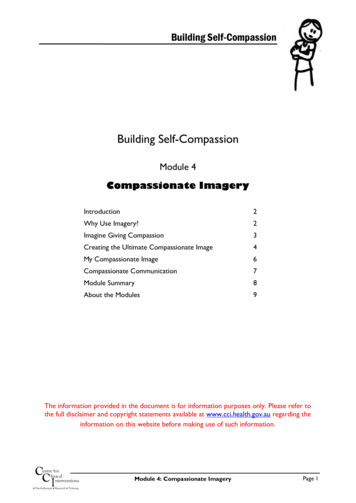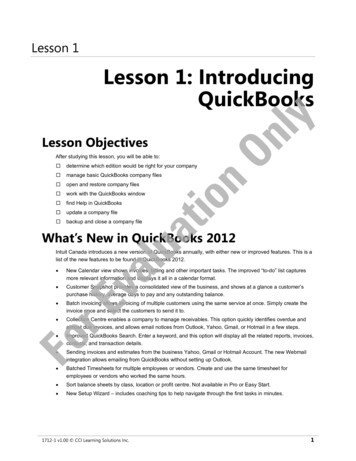
Transcription
Building Self-CompassionBuilding Self-CompassionBuilding Self-CompassionModule 4Compassionate ImageryIntroduction2Why Use Imagery?2Imagine Giving Compassion3Creating the Ultimate Compassionate Image4My Compassionate Image6Compassionate Communication7Module Summary8About the Modules9The information provided in the document is for information purposes only. Please refer tothe full disclaimer and copyright statements available at www.cci.health.gov.au regarding theinformation on this website before making use of such information.forCentrelinicalC Interventions Psychotherapy Research TrainingModule 4: Compassionate ImageryPage 1
IntroductionBuilding Self-CompassionWe are now ready for some compassion! So far we have been setting the scene for self-compassion.Through your attention retraining exercises you should now be more aware when you are going through adifficult experience and are in need of some compassion, and ideally you can now mentally step backenough to be in a position to provide this for yourself. You can also slow yourself down, by using yourbreathing to create a calming physical state that is conducive to being compassionate towards yourself. Buthow do you actually send some compassion your way?This module will teach you some novel strategies for being able to further the work that your slowbreathing will have started. That is, to further activate your soothe system, by stimulating compassionatefeelings within you. Triggering compassionate feelings within you will rely on developing your very owncompassionate image. The goal of these modules will be to find a compassionate image that works for youin unlocking compassionate feelings. These feelings can then be directed towards yourself when you mostneed them.Why Use Imagery?You may be wondering what we mean by an image, and why imagery would be used to stimulatecompassionate feelings? We think in images all the time, often without even realising it. Below is a list ofwords. As you read each one pause before moving to the next and notice what is triggered off in yourmind by each word:BeachFlowerBicycleHolidaysAppleWhat did you notice? Chances are that certain pictures flashed throughyour mind, in other words images popped into your head. For the word‘beach’, it may have been a memory of childhood holidays at a particularbeach, or an imagined tropical beach paradise that you haven’t as yet visited,or your local beach that you go to regularly, or a less pleasant beach imagemay have come to mind, like something treacherous and dangerous. It mayhave been a sustained picture almost like a movie playing in your head, orjust brief flashes and glimpses that passed through your mind. It may nothave just been a picture image either. For some of us the image might bemultisensory where you can almost hear what the wave’s sound like, orsmell the salt air, or feel the cool water or warmth of the sun on your skin.Hopefully you get a sense that images are not that unusual, they are just a form of thinking that is very richin terms of sensory information (i.e., visual pictures, sounds, touch sensations, tastes, smells). But, why useimagery?Research shows that imagery can be very powerful in triggering emotions.Our brain is not very good at distinguishing an image from reality, so it willoften process and respond to an image, as if it is something occurring for real.As an example, think of a food that you really love in my case it would bechocolate cake!Now close your eyes and imagine that you have that food in front of you.Imagine getting up close and having a smell of it what do you notice howdo you feel do you notice any physical sensations how does your mouthfeel?forCentrelinicalC Interventions Psychotherapy Research TrainingModule 4: Compassionate ImageryPage 2
Building Self-CompassionMany people notice they have a physical reaction when they imagine their desired food, often noticing thattheir mouth even starts to salivate! That is because our brain is processing the image and responding to itas if the food were really in front of us.But what do images of chocolate cake have to do with self-compassion? To build self-compassion we needto first stimulate compassionate feelings, and then direct those feelings towards ourselves when we arestruggling. If we know that images are a really effective way to activate feelings, then let’s be strategic anduse this knowledge to our advantage. With this in mind, if we can find an image that elicits compassionatefeelings within us, we can use this as a tool to help direct compassion towards ourselves.Our aim is to develop an image that triggers a compassionate attitude or mindset within us – prompting usto feel, think and act in compassionate ways. We will now look at two types of compassionate images thatmay work for you. We would recommend having a go at each imagery exercise, trying each image ‘on forsize’, and seeing which is most effective for triggering feelings of compassion within you. The followingexercises are adapted from Paul Gilbert’s Compassion Focused Therapy approach.Imagine Giving CompassionSee if you can bring to mind someone you care about, someone that you feel great warmth towards,someone that you always want to be there for unconditionally, to be on their side supporting them throughthe trials of life. This could be a family member, or a friend, or even a pet.Write down the name of the person that springs to mindClose your eyes and go through a few rounds of your slow breathing to get yourselfprepared. Now imagine that this special person is in front of you and that they needyour help. Don’t get caught up in the details of what is happening for the otherperson, instead just focus on giving them the unwavering compassion that they need.Allow yourself to feel a deep sense of caring and concern for them. Allow yourdesire for them to be happy and free from struggle to come to the forefront.Now notice what emotions are you feeling? Notice what physical sensations accompany those feelings?What is your facial expression like towards this other person? What is your body posture like towards theother person? What things are you saying to them? What is your tone of voice like as you say thosethings? What are you doing to comfort and help this person?Spend a few minutes just appreciating this image of giving compassion to another. Pay particular attentionto the compassionate feelings this image generates. See if you can allow these feelings to take over, togrow inside you, almost feeling your whole body fill with compassion. When you open your eyes, fill in thefollowing details regarding what you experienced.Emotions:Physical Sensations:Facial Expression:Body Posture:Advice:Voice Tone:Actions:forCentrelinicalC Interventions Psychotherapy Research TrainingModule 4: Compassionate ImageryPage 3
Building Self-CompassionIf you found this exercise useful in triggering feelings of compassion within you, then practice bringing thisimage to mind regularly, so that the image becomes easily accessible and can be used as your compassion‘on’ button. You could even carry a photo of this person with you, in your phone or printed in your wallet,as a visual reminder. You could even frame a photo of them and place it somewhere in your daily lifewhere you notice you tend to be your most self-critical (e.g., next to your bathroom mirror if you noticeyou tend to criticise your appearance a lot).If you found that the compassionate feelings weren’t very strong, or that it was difficult to come up with animage that works for you, it may mean that you need more practice to strengthen this image. If feelingsunrelated to compassion popped up (e.g., sadness, guilt, longing, regret, anger, loss, loneliness, etc.), theneither you may need to pick a different person to direct your compassion to, or maybe this isn’t the mosthelpful method for you for generating compassionate feelings. Don’t worry, the next option might be moreuseful for you.Creating the Ultimate Compassionate ImageRelationships are complicated, and some of us may not have people in our lifewho we feel pure compassion towards, hence it is hard for us to really benefitfrom the imagery exercise we have just covered. If this is the case, then theprevious image may not be effective in triggering pure untainted compassion,which is really what we are looking for.Because of this, we often find that this imagery exercise is more useful, as itinvolves creating your very own ultimate compassionate image from yourimagination. This fantasy compassionate image can be whatever you want.There is no right or wrong when it comes to creating your own personalisedimage that represents pure compassion. In fact, the actual image you develop isirrelevant. It doesn’t matter how fanciful or realistic the image is. Remember,we are just using this image to activate feelings of pure compassion within us, sowhatever image achieves this aim is okay.Start by closing your eyes and slowing your breath as you are now very familiarwith Now, when you think of compassion notice what images, thoughts or feelings arise in you? Don’t try toohard, just allow whatever is there to be there, or allow things to come and go as they please Now allow an image to arise that represents compassion for you. Take your time to develop an image thatsymbolises all the things that go with compassion. If nothing comes immediately, that’s ok, just take yourtime and see what emerges no matter how strange it may seem. It doesn’t have to be a vivid picture, just afelt sense of the image is ok too. If numerous images come up (a bit like a slide show), that’s ok too, wecan see which one you settle on as time goes on.See if you can start to develop an image that holds warm feelings towards you Allow an image that conveys a sense of understanding for you, for your struggles and your feelings Allow an image that shows kindness, care and concern for your well-being Allow an image that is strong and wise as it supports you Allow an image that is completely accepting of you just as you are forCentrelinicalC Interventions Psychotherapy Research TrainingModule 4: Compassionate ImageryPage 4
Building Self-CompassionNow, notice if the image is of a person or not, something real or imagined, an animal, some other being oran aspect of nature. Is it young or old? Male or female? What colours or light are associated with it?How does this image make you feel? What physical sensations in your body go with these feelings? Whatfacial expression does the image display towards you? What body posture or stature does it conveytowards you? How does it sound or communicate with you? What things does it say to you? What tonedoes it use? What does it do to help or comfort you?When you feel ready you can let go of the image and open your eyes.Now have a go at describing your ultimate compassionate image below in words and/or pictures.My Ultimate Compassionate Image is (describe in words and/or draw a picture)Also below note the various experiences that went with this image. How did the image make you feelemotionally and what physical sensations did the image generate within you? What facial expression andbody posture/stature did the image convey? What sorts of advice was the image giving? What voice tonedid the image use? What comforting actions did the image offer?Emotions:Physical Sensations:Facial Expression:Body Posture/Stature:Advice:Voice Tone:Actions:When people do this exercise, some automatically bring to mind religious figures or a wise grandparentwho is no longer with them. Keep in mind that for the compassionate image to be truly compassionate,you need to feel that you could tell it your deepest darkest secrets, thoughts, desires and feelings, and thatthey would not judge you, they would not turn away from you, but instead would accept youunconditionally. If your image has a judgemental bone in its body or it conjures up feelings other thancompassion, then try the imagery exercise again and shop around for a different image.forCentrelinicalC Interventions Psychotherapy Research TrainingModule 4: Compassionate ImageryPage 5
Building Self-CompassionCreating your ultimate compassionate image will typically take a few attempts. Try to treat this as acreative and fun process. Some people will easily stumble on an image that works for them straight away,but then when they repeatedly bring the image to mind, it might evolve and change as more detail is addedto enrich the image. Others may struggle to settle on a specific image at the start, and they might try a fewdifferent images on for size before settling on one that works for them. It is ok for this to be a work inprogress that takes some time to fully develop.My compassionate image is of a large rock, almost a minimountain emerging from a beautiful pool of calm ocean water. Myrock is indented at the top with mossy soft grass, the perfect sizeto curl up in and be supported and comforted, and at the sametime standing on the rock looking out gives a sense of strengthand security. I know other people who have developed images ofa wise tree that has been standing for hundreds of years, withsprawling warm green foliage that provides shelter and protection.Others have created a very wise old woman or man, notsomeone from real life but a fantasy person, who has experiencedall of life and provides unconditional care and support. Othershave an animal as their compassionate image, for example asteadfast beautiful stallion that is always on their side. Hopefullyfrom these examples you can see there is no right or wrong, justyour imagination and what works for you in triggering feelings ofcompassion.My Compassionate ImageBy now you have tried two different compassionate images on for size. It is now time to pick the one thatfits best for you and be clear about how you are going to strengthen this image, so that it can be used as aneffective and efficient compassion ‘on’ button when you need it.
exercises are adapted from Paul Gilbert’s Compassion Focused Therapy approach. Imagine Giving Compassion See if you can bring to mind someone you care











